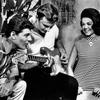grayn

Joined: Apr 07, 2012
Posts: 114
East Lancashire



|

Posted on Jul 14 2014 04:42 AM
The thing that caught my attention, with this particular Jazzmaster, was it's looks. The "oxblood" coloured body and head, with a tort scratchplate and creamy white pickups and "witch hat" knobs, just looked amazing. And boy was I pleased that it played and sounded just as good as it looked.
I've had this guitar for a few weeks now and have played it every day, through my current amp of choice, a Peavey Classic 30. I understand that the guitar is made from all American parts but assembled in Mexico, to keep the price down. And they even included a very nice Fender hard case. I've owned a couple of Jazzmasters before, a Classic Player and a Blacktop. Both were decent guitars but this model stands head and shoulders above them. One aspect I was particularly pleased with, is the tremolo. It's as smooth as can be. Many Jazzmaster and Jaguar trems, I have tried, have always seemed rattley, especially when used vigorously.
The Fender Troy Van Leeuwen Jazzmaster has a Mustang, brass-saddled bridge. The neck is C-profiled, with a 7.25”radius, bound rosewood, fingerboard and block markers. The pickups are American Vintage ’65 Jazzmaster single-coils. As with most JMs, you get a lead/rhythm switching, for variety. To be honest, I have it on lead all the time. I've always been a player, on basses or guitars, to have tones and volumes at full, unless they are active. I just tend to use the pickup selector and playing technique for tonal variety.
I pretty much exclusively use this guitar for instrumental surf music. I use plenty of the Classic 30's, delightful, spring reverb (which is even better than the one I had on my Fender Princeton Re-issue) and a single repeat, slap-back echo, most of the time. I also occasionally add tremolo, rotary speaker effect and/or longer, multi-repeat echo. And within it all, the Fender Troy Van Leeuwen Jazzmaster just sounds wonderful. And for me, is the ultimate surf guitar. It doesn't quite have the full-bodied clarity, I got previously, from my Burns Marvin 64 but somehow, it just sounds more authentic, with a lush, sparkling tone.
So yes, this guitar was a very good buy, for me.



— http://soundcloud.com/graham-pike
|
ludobag

Joined: Jun 05, 2010
Posts: 620
at south of


|

Posted on Jul 14 2014 04:50 AM
that 's a really cool jazz ,the colour is perfect
|
crumble

Joined: Sep 09, 2008
Posts: 3158
Guildford England





|

Posted on Jul 14 2014 06:26 AM
The bridge post adjustment holes look bigger than normal. Nice guitar.
|
SaschaReynders

Joined: Dec 26, 2013
Posts: 251



|

Posted on Jul 14 2014 08:03 AM
I got one of these beauties about 2 months ago and I haven't played any of my other guitars since, it's simply that good. The AV 65 pickups sound amazing and the overall build quality and finish is very good for an MIM Fender. And to me it's one of the prettiest Jazzmasters ever. There are some who find it a bit too expensive for a Mexican, but with it's AV pickups, bridge and trem unit AND the hardshell Fender case I think it's well worth the money.
I'm not sure ALL parts on this JM are US made though. IIRC Troy specifically asked for his signature model to be MIM so it would be affordable, so I suspect there will be some differences (wood, wiring, electronics ?) between this one and it's AV counterparts.
crumble wrote:
The bridge post adjustment holes look bigger than normal
You're probably right: I have to use a slightly bigger hex key than the one I need for the AVRI bridge on my Jaguar.
— "Duck Tape is like The Force: it has a light side and a dark side and it holds the universe together"
https://www.facebook.com/pages/Speedball-JR/151771678181829?fref=ts
https://twitter.com/SPEEDBALLJR
https://itunes.apple.com/be/artist/speedball-jr/id389972205
|
josheboy

Joined: Mar 13, 2009
Posts: 2367
Twin Cities, MN




|

Posted on Jul 14 2014 09:30 AM
That is a really good looking guitar!
|
SaschaReynders

Joined: Dec 26, 2013
Posts: 251



|

Posted on Jul 14 2014 01:40 PM
One thing I noticed though, and I see it in these pics as well, is that the rosewood fretboards on these models are very pale and dry... Dunno if they leave the factory like that, or if this is the result of bad conditioning during transport overseas. But I applied some Dunlop lemon oil and fretboard conditioner, and it already looks and feels a lot better.
— "Duck Tape is like The Force: it has a light side and a dark side and it holds the universe together"
https://www.facebook.com/pages/Speedball-JR/151771678181829?fref=ts
https://twitter.com/SPEEDBALLJR
https://itunes.apple.com/be/artist/speedball-jr/id389972205
|
IvanP

Joined: Feb 27, 2006
Posts: 10331
southern Michigan







|

Posted on Jul 14 2014 01:46 PM
SaschaReynders wrote:
One thing I noticed though, and I see it in these pics as well, is that the rosewood fretboards on these models are very pale and dry... Dunno if they leave the factory like that, or if this is the result of bad conditioning during transport overseas. But I applied some Dunlop lemon oil and fretboard conditioner, and it already looks and feels a lot better.
That is the case on pretty much all new Fenders, going back a few years, even my '65 AVRI Strat. I think the available rosewood is no longer of the quality it used to be....
— Ivan
Lords of Atlantis on Facebook
The Madeira Official Website
The Madeira on Facebook
The Blair-Pongracic Band on Facebook
The Space Cossacks on Facebook
The Madeira Channel on YouTube
|
crumble

Joined: Sep 09, 2008
Posts: 3158
Guildford England





|

Posted on Jul 14 2014 02:22 PM
It's probably just another rosewood species. It looks very smooth compared to my Squier JV which if you examine closely has canyons and pores galore.
|
JakeDobner

Joined: Feb 26, 2006
Posts: 12159
Seattle



|

Posted on Jul 14 2014 02:43 PM
You see light boards going back to the late '60s.
Fender also appears to save the darker woods for custom shop instruments.
|
Bob_Kennedy

Joined: Feb 27, 2012
Posts: 316
Mesa, AZ.

|

Posted on Jul 14 2014 08:55 PM
Fender has been using Pau Ferro (AKA Morado or Bolivian Rosewood) for years now. It is lighter in color & not a true rosewood. It is excellent wood though, so don't think they are skimping on fretboards. It's more plentiful than East Indian Rosewood. They generally save the E.I. Rosewood for AVRI & custom shop stuff.
— Otto & The Ottomans
Kennedy Custom Guitars
|
grayn

Joined: Apr 07, 2012
Posts: 114
East Lancashire



|

Posted on Jul 15 2014 01:10 PM
It certainly is quite different from other rosewood 'boards, I own.
There's some very obvious grain, in parts.
I didn't find mine dry though. It's very smooth and comfortable.
— http://soundcloud.com/graham-pike
|
pscates

Joined: Oct 26, 2013
Posts: 45

|

Posted on Jul 15 2014 01:56 PM
I love this guitar. It has the alder body, the '65 pickups, tremolo in the traditional spot, the witch hat knobs, vintage tuners, etc. All the nice traditional touches.
BUT you get that amazing color, the matching peghead and the block/bound neck...things you don't get on any current Fender offset at any price (without going through the custom shop).
I don't even mind that big honkin' rhythm circuit toggle switch.
I'm thrilled to hear the kind of music you play with it because, at first, I was kinda put off by the artist and his style (not on a personal level, I just assumed for someone like him it would have overwound this and modern that). I got to reading the specs and realized "this is very close to an AVRI, but with a cooler color and neck!". Reading this review kinda clinches it for me. Thanks for sharing.
I'd rather have a "close enough" guitar with a unique, eye-catching appearance than a sunburst or Olympic White AVRI for $1,000 more. But that's just me.
Last edited: Jul 15, 2014 13:59:21
|
LeeVanCleef

Joined: Oct 05, 2011
Posts: 744
France


|

Posted on Jul 15 2014 07:23 PM

— Old punks never die... They just become surf rockers.
|
IvanP

Joined: Feb 27, 2006
Posts: 10331
southern Michigan







|

Posted on Jul 15 2014 08:21 PM
Bob_Kennedy wrote:
Fender has been using Pau Ferro (AKA Morado or Bolivian Rosewood) for years now. It is lighter in color & not a true rosewood. It is excellent wood though, so don't think they are skimping on fretboards. It's more plentiful than East Indian Rosewood. They generally save the E.I. Rosewood for AVRI & custom shop stuff.
Now, THIS is very interesting! It's the first I've heard of it. Any more info about this, Bob, such as when they made the switch? Why is it not a true rosewood? Why is Fender still calling it rosewood? Anything that can be done to make it darker? Lemon oil?
Thanks!
— Ivan
Lords of Atlantis on Facebook
The Madeira Official Website
The Madeira on Facebook
The Blair-Pongracic Band on Facebook
The Space Cossacks on Facebook
The Madeira Channel on YouTube
|
Bob_Kennedy

Joined: Feb 27, 2012
Posts: 316
Mesa, AZ.

|

Posted on Jul 15 2014 09:31 PM
Ivan, the first I heard of it was maybe 6 or 7 years ago on the Telecaster forum. There was a lengthy discussion about it with a couple of Fender employees chiming in & confirming it along with posting a couple pictures of pallets of Strat necks with Pau Ferro fretboards awaiting finishing. I've also spoken with an exec from Fender about it at the Tempe guitar show a couple years back. I don't know exactly when they started exploring alternative fretboard woods, but I suspect it could've been as early as the late 90's. The supply of East Indian rosewood is dwindling & it's becoming more expensive, so alternatives need to be found. Pau Ferro's scientific name is Caesalpinia ferrea. To be a true rosewood, it would have to be part of the Dalbergia family. Fender probably calls it rosewood because one of its common names is "Bolivian Rosewood". As I said before, it is an excellent hardwood. In fact, I like it better than East Indian rosewood & I have used it for fretboards before. It machines & sands beautifully. It is slightly more dense than E.I. Rosewood too. It tends to resemble Brazilian Rosewood in looks, feel & tone. It usually has more brown tones in it rather than the purple tones found in E.I. Rosewood. Lemon oil will darken it up nicely.
— Otto & The Ottomans
Kennedy Custom Guitars
|
IvanP

Joined: Feb 27, 2006
Posts: 10331
southern Michigan







|

Posted on Jul 15 2014 09:40 PM
Absolutely fascinating, Bob! Thanks very much for sharing that. It clears up a lot of questions that I've had for the last few years. The boards feel fine, and they sound good, so I have no issues with them at all, personally. (I think I remember some Yamaha guitars using Pau Ferro fretboards some 10-15 years - I have a cheapo Yamaha Pacifica (Strat-like) that I think has a board with that wood.)
— Ivan
Lords of Atlantis on Facebook
The Madeira Official Website
The Madeira on Facebook
The Blair-Pongracic Band on Facebook
The Space Cossacks on Facebook
The Madeira Channel on YouTube
|
pscates

Joined: Oct 26, 2013
Posts: 45

|

Posted on Jul 15 2014 09:51 PM
Man, I keep looking at the pics above. That's such a snazzy guitar. I love how the white around the pickguard makes it pop off that dark body. So crisp and classy looking. And all the white accents throughout look great, and pop nicely...knobs, pickups, binding, blocks, etc. There's just nothing wrong with that guitar, visually.
I honestly believe if I had $2,000 or so to spend on a guitar, I'd just get this one and pocket the change. Unless I went with with something homemade or custom-built where I got to choose every little thing, I don't think I could get anything nicer-looking off-the-rack, stock.
What's the story with the color? Is that something Fender has used in the past, or is it something TVL requested? Is that a color he's used on other guitars, a signature sort of thing (sorry, I don't know anything about the guy other than the very basics)?
I know that I've never seen, or heard of, the color before now (but I'm not a Fender historian either). I've only heard it used in relation to grill cloth color.
Last edited: Jul 15, 2014 21:58:00
|
JakeDobner

Joined: Feb 26, 2006
Posts: 12159
Seattle



|

Posted on Jul 15 2014 11:29 PM
pscates wrote:
I honestly believe if I had $2,000 or so to spend on a guitar, I'd just get this one and pocket the change. Unless I went with with something homemade or custom-built where I got to choose every little thing, I don't think I could get anything nicer-looking off-the-rack, stock.
I haven't played one of these yet but if I had to choose between having this guitar and pocketing some cash I'd definitely look at the poly finish. If Im paying so much for a guitar I obviously want it to be a main guitar and get lots of use.
Can i hear a difference between poly and nitro? I have no idea, pickups/setup/strings are bigger factors than finish type in my opinion.
However... a conversation I've been having recently with friends, and we all agree, is that poly isn't as satisfying. Our bassist has a killer MIM 60s Jazz Bass that should be worn through, but looks pristine. He has worn through two bridge pickup covers(the metal ones)... Yet the finish is new. He really laments that the finish doesn't age or feel broken in like the brilliant feel of a worn guitar. The dirt and grime just doesn't make the neck nice and smooth/slick. the finish will never seep into the finish. It will always feel nasty when the least amount of sweat gets on the guitar.
These factors, not tone, are what would cause me to spend more for a nitro instrument if it was an instrument I intended to truly make my own.
|
crumble

Joined: Sep 09, 2008
Posts: 3158
Guildford England





|

Posted on Jul 16 2014 09:54 AM
JakeDobner wrote:
I've been having recently with friends, and we all agree, is that poly isn't as satisfying. Our bassist has a killer MIM 60s Jazz Bass that should be worn through, but looks pristine. He has worn through two bridge pickup covers(the metal ones)... Yet the finish is new. He really laments that the finish doesn't age or feel broken in like the brilliant feel of a worn guitar. The dirt and grime just doesn't make the neck nice and smooth/slick. the finish will never seep into the finish. It will always feel nasty when the least amount of sweat gets on the guitar.
There's only one thing worst than damaged poly on guitars and that's poly relicing! My '83 JV is poly coated and as you say, (especially with some polishing) from a short distance it looks new. But luckily it's a thin-skin over basswood which dents easily and the paint sticks to the dent rather than breaking off. The back of the body has hundreds of tiny dents and looks very cool in my opinion.
|
Sonichris

Joined: Mar 06, 2006
Posts: 1910
Wear gloves - I'm in the Rockies







|

Posted on Jul 16 2014 10:12 AM
IvanP wrote:
Absolutely fascinating, Bob! Thanks very much for sharing that. It clears up a lot of questions that I've had for the last few years. The boards feel fine, and they sound good, so I have no issues with them at all, personally. (I think I remember some Yamaha guitars using Pau Ferro fretboards some 10-15 years - I have a cheapo Yamaha Pacifica (Strat-like) that I think has a board with that wood.)
The Stevie Ray Vaughan Strat has a Pau Ferro fret board. I think the first batch was more traditional rosewood, but ever since its been Pau Ferro. That guitar has been around since 1992.
I always wondered why that particular wood for a guitar that was for the most part a vintage style reissue?
And - to get back on topic - the JM in the OP looks great!
— "You can't tell where you're going if you don't know where you've been"
|







































